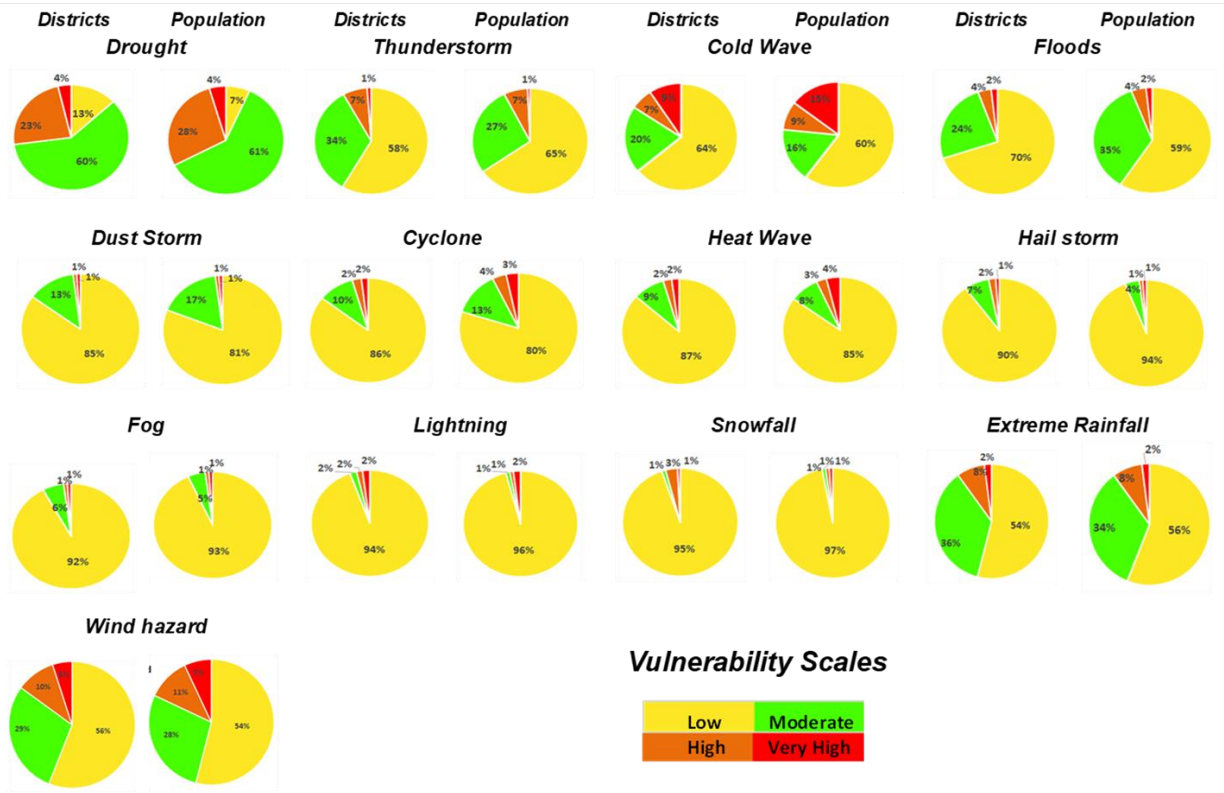Vulnerable districts of India
Vulnerable districts of India
Climate Hazards and Vulnerability Atlas of India
India Meteorological Department (IMD) monitors and provides impact-based early warning services for various meteorological disaster events at different temporal and spatial scales to support disaster risk reduction management. As a part of these services, IMD has now prepared a Web version of Climate Hazards and Vulnerability Atlas of India for the thirteen most hazardous meteorological events, viz. Cold wave, Heat Wave, Flood, Lightning, Snowfall, Dust Storm, Hail Storm, Thunderstorm, Fog, Strong winds, Extreme rainfall, Drought and Cyclone that cause loss of life, injury or other health impacts, property damage, loss of livelihoods and services, social and economic disruption or environmental damage.
To access the maps, click here.
Vulnerability status of districts
Percentage of districts and population affected by disastrous weather events in different categories of vulnerability scales based on the Normalized vulnerability index for eleven out of these thirteen climate hazards are given below using pie charts and brief description of thirteen hazardous events are below:

Drought:
- 87% of the districts and 93% of the population are moderate to very highly vulnerable (27% of the districts and 32% of the population are highly vulnerable).
- Madhya Pradesh is the most vulnerable state (19 districts are high to very high) followed by Uttar Pradesh (15 districts), Gujarat (14 districts), Karnataka (14 districts)
Thunderstorms:
- 42% of the districts and 35% of the population are moderate to very highly vulnerable (8% of the districts and population are highly vulnerable) for Thunderstorms.
- Assam and UT of Jammu & Kashmir (12 districts each are high to very high), Tripura (8 districts) are most vulnerable.
Cold wave:
- 36% of the districts and 40% of the population are moderate to very highly vulnerable (16% of the districts and 24% of the population are highly vulnerable) for cold wave.
- Uttar Pradesh (75 districts) is the most vulnerable state for cold waves.
Floods:
- 30% of the districts and 41% of the population are moderate to very highly vulnerable, annually 6% of the districts and population are highly vulnerable.
- In the case of states, Assam (23 districts are high to very high) is the most vulnerable state for floods.
Dust storm:
- 15% of the districts and 19% of the population are moderate to very highly vulnerable (2% of the districts and population are highly vulnerable) for Dust storm.
- States of Uttar Pradesh (3 districts are high to very high) and Assam (2 districts are high to very high) are the most vulnerable states for Dust storm events.
Cyclones:
- 14% of the districts and 20% of the population are moderate to very highly vulnerable (4% of the districts and 7% of the population are highly vulnerable) for cyclones.
- Most of the coastal districts of east coast (Tamil Nadu:11, Andhra Pradesh: 9, Odisha: 6 and West Bengal: 3) are high to very highly vulnerable for Cyclone.
Heat wave:
- 13% of the districts and 15% of the population are moderate to very highly vulnerable (4% of the districts and 7% of the population are highly vulnerable) for heat waves
- The states of Rajasthan (15 districts) and Andhra Pradesh (13 districts) are the most vulnerable states for Heat Waves.
Hail Storm:
- 10% of the districts and 6% of the population are moderate to very highly vulnerable (3% of the districts and 2% of the population are highly vulnerable) for Hail storm.
- State of Uttarakhand (7 districts) followed by Union territory of Jammu & Kashmir (5 districts) are most vulnerable for Hail storm.
Fog:
- 8% of the districts and 7% of the population are moderate to very highly vulnerable (2% of the districts and population are highly vulnerable) for the fog annually.
- In the month of December most of the districts of Delhi and a few districts of Uttar Pradesh; in January, most of the districts of Delhi, many districts in Uttar Pradesh and Tripura and few districts in Haryana, West Bengal and Manipur are most vulnerable for fog.
Lightning:
- 6% of the districts and 4% of the population are moderate to very highly vulnerable in the case of lightning, annually 4 % of the districts and 3% of the population are highly vulnerable.
- State of Odisha (20 districts) ranked top in the most vulnerable states for lightning.
Snowfall:
- 5% of the districts and 3% of the population are moderate to very highly vulnerable (4% of the districts and 2% of the population are highly vulnerable) for the snow fall events.
- Union Territory of J&K and Ladakh (19 districts) and state of Himachal Pradesh (8 districts) are most vulnerable for snow fall.
Wind Hazards:
- 44% of the districts and 46% of the population are moderate to very highly vulnerable.
- Most of the Coastal districts of Odisha, southern coastal districts of Andhra Pradesh and northern coastal districts of Tamil Nadu, few districts of Bihar, Jharkhand, Rajasthan, Gujarat and NE states experience high extreme wind speed of greater than 55m/s (50 years return period extreme value).
Extreme Rainfall:
- 46% of the districts and 44% of the population are moderate to very highly vulnerable.
- All the districts of entire western coast, most of the districts of Assam & Meghalaya, Tripura, Kerala and few districts of Bihar, Jharkhand, West Bengal, Karnataka, Odisha, Maharashtra and Uttarakhand have maximum probable frequency of heavy rainfall events of more than 20 days during the southwest monsoon season.
Source : IMD
Last Modified : 3/19/2024
Comprehensive Weather Reports on Doordarshan and A...
Through the app, users can access observed weather...
This topic covers the information related to Flood...
Topic describes about naming conventions followed ...
